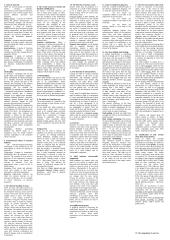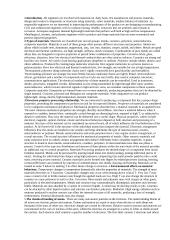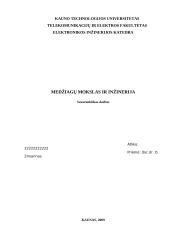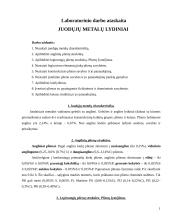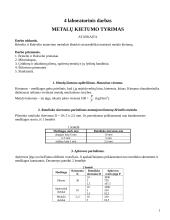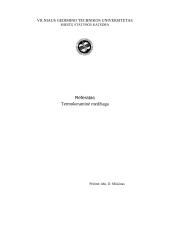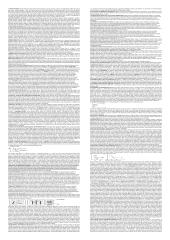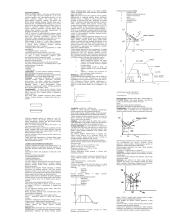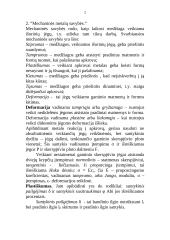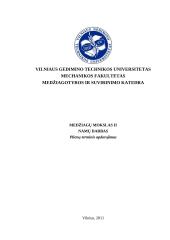Konspektai
Theory of material science
4.4. Carbon Steel Steel is an alloy of iron and carbon, and carbon content is 2.14% (practically 1.5%).Steel is anmed carbon steel when in its content exist Fe-C and permanent impurities. These impurities are Si, S, P. In other case when a certain elements usually metals Ni, Co, W,V are introduced into steel, such steel is named alloyed steels. Carbon steels are classified in some groups depending on certain criterias: • According C content, carbon steels are classified as follows: 1.Ingot iron 0-0.02%C 2.Low carbon steel 0.02-0.3%C 3.Medium carbon steel 0.3-0.06%C 4.High carbon steel C>0.6% • According to the content of harmful impurities (S,P) 1. Common steels S=0.05%, P=0.04% 2. Quality steels S=0.04%, P=0.03% High quality steels S up to 0.025%, P up to 0.025% • According to degree of oxidation 1.Rimming steels (deoxidated by Mn)) 2.Semi killed steels (deoxidated by Mn,Al) 3.Killed steels (deoxidated by Mn, Al, Si) • According to the employement 1.Structural steels 2.Tool steels 3.Casting steels 4.Free cutting steels CARBON STEELS→(Structural→(Common quality, quality), Tool→(quality, high quality), Special purpose→(free cutting, casting)) Common quality structural steels are produced by common technology. They are cheap since there is quite little remove of harmful impurities. These steels are supplied in normalized state in shape of rolled workpieces: sheets, rods, and so on and so force. This steel according GOST is designated by letters and digit number, i.e. CT0, CT1, CT2.CT3-structural steel of common quality. Sometimes there can be some indexes CT0kΠ, CT1ΠC, CT1CΠ kΠ-reamming steel ΠC-semi killed steel CΠ-killed steel DIN standard St22 Fe 490-2 EN-European standard S185 Structural quality steel has less harmful impurities and is more expensive (25%) comparing with common quality carbon steel. According GOST 08, 10, 15, 20,….,60, 65 For example, 45-structural quality carbon steel with carbon content 0.45% C DIN,EN-C30,C35,C40 Ck22-0.22%C Tool Steel has more than 0.7%C.GOST-У7, У8,…, У12, У13. У12- carbon tool steel with 1.2% of carbon, У9-0.9%C There can be У7A, У8A,… У12A, У13A. Ex: У12A-carbon tool steel C=1.2%, A-improved DIN- C75W(W-group of quality)-0.75%C Free cutting steel is easier machined because of composing a breaking chip. The cutting tool wears less. There is more S and P in content of this steel. According GOST- A11, A20, A30, A40Г A11-free cutting steel C=0.11% DIN,EN: 9S20 S-0.2%, C-0.09% 10S22 S-0.22%, C-0.1% Casting carbon steel is designated according GOST: 15Л, 20Л, 25Л, …,55Л. 20Л-casting carbon steel 0.2%C DIN, EN:G-C20, C=0.2% 4.5 CAST IRON It is an alloy of iron, carbon and some impurities. Content in cast iron is higher than 2.14%. This alloy is brittle, so it can’t be forged: the articles are made by casting.2 kinds of cast irons are employed: cementite and graphite cast irons. In the first almost all carbon is in the compound of Fe3C. In the second- in the form of free graphite. Cementite cast iron for white color of its fracture is called white cats iron. The structure of white cast iron is given in Fe-C cementite constitutional diagram. The main structure constituent is hard ledeburite and for that reason it is white cast iron. Besides it is brittle. White cast iron sometimes is used for parts that must be resistant to wear. Graphite cast iron according to the mode of production and the shape of graphite inclusions is classified into 3 main groups: 1.Grey cast iron 2.Malleable cast iron 3.Ductile cast iron Grey cast iron Flake type Malleable cast iron Nodular type Ductile cast iron globular or spheroidal The graphite inclusions are arranged in the metallic matrix which is the same like in steels. It may be perlitic, perlite+ferrite, or ferrite. Grey cast iron This cast iron is so called because of the grey color of its fracture.Grey cast iron is very widely used in engineering materials. Comparing it with steel it is cheaper for its simplier production and higher content of impurities.G.c.i. distinguishes by good casting, antifriction and damping properties. Machineability is not sensitive to stress concentrators, but G.c.i. posseses low tensile strength, is brittle and it cannot be plastically deformed. Machine tools and gear box frames, flanges are casted of Grey cast iron. G.c.i. is obtained when melted metal is cooled slowly and there is enough content of Si in cast iron(1-3%Si). According GOST: CЧ10, CЧ15, CЧ20-200MPa DIN GG-20, EN-GJL-155 Malleable Cast iron This cast iron is more ductile than Grey cast iron, but it cannot be worked by forging.M. cast iron is of higher ductility because of its nodular graphite. The articles of m.cast iron are obtained by 2 steps: At the first stage the article of cast iron is casted and at the second stage this article is annealed at high T(950-10000C) and prolonged duration. During this process the cementite transforms into austenite and nodular graphite. The entire cycle of annealing is durable 70-80h, so the cost of m. cast iron is high. This cast iron is used for articles of complex shape that are acted by dynamic loads.EX:gears, chains, pins… M. cast iron is designated in such a way: GOST KЧ 50-3, KЧ37-12. According DIN GTW 65-02(black core), GTS 55-04(white core) Ductile cast iron Graphite in ductile cast iron is spheroidal.Steel in many cases is changed by ductile cast iron. These cats irons are used in elements of rolling mills, forging presses, steam turbines,etc..In order to get ductile cast iron it is necessary to inoculate (modify) the poured cast iron with Mg or cerium(Ce) that initiate the formation of spheroidal graphite during primary crystallization . Designation: GOST BЧ 50 DIN GGG-50 EN GJS-500-7 4.6.Kinds of heat treatment Heat treatment implies various technological processes at which the structure and properties of metal or alloy are changed by heating and cooling.Heat treatment can be applied ingots, castings, semifinished products, welded joints and various elements of machines and instruments. The principle kinds of heat treatment are annealing, hardening, tempering and ageing. Each of them has a number of varieties. Annealing is a kind of heat treatment after which a metal or alloy acquires a structure close to the equilibrium structure. Annealing causes softling of metals and alloys which is accompanied with increase of ductility and relief of residual stresses.The temperature of heating in in annealing depends on the composition of an alloy and the particular kind of the process. The rate of cooling from the annealing temperature is usually not high (30-2000C/h) Hardening is a kind of heat treatment which forms a non-equilibrium structure in an alloy. Non-equilibrium structures can be produced by heat treatment only in cases when the alloy being treated undergoes certain transformation in solid state. A change of solubility, polymorphic transformations in SS , the composition of high temperature SS by eutectoid reaction. To form a non-equilibrium structure structure in an alloy it is heated above the temperature of the phase transformation in the solid state and then cooled quickly. Fast cooling is essential for preventing the equilibrium transformation during cooling. Structural and tool making alloys are hardened in order to increasetheir strength. Tempering and ageing are applied to hardened alloys. They involve certain phase transformation ahich make the metal structure approach to the equilibrium. A combination of hardening and tempering ar hardening and ageing is almost aimed to obtain higher properties as compared to those resultant from annealing. Any process of heat treatment consists from 3 stages: heating, izothermal holding and cooling. The heating stage or sometimes entire heat treatment process (annealing) is carried out in a heating furnace . Each heat treatment may be shown by a certain graph. I-heating II-holding III-cooling 1-hardening 2-tempering 3-annealing 4-normalizing 4.7 HEAT TREATMENT OF ALLOYS UNDERGOING NO PHASE TRANSFORMATIONS IN SOLID STATE. Some kinds of heat treatment involve no solid state phase transformations in the metal and result only in that the metal structure is brought more closely to equilibrium. These methods are employed for instance for decreasing residual stresses in article obtaining the recrystallization of plastically deformed semi finished products, or diminishing intercrystalline segregation in ingots and castings. The corresponding heat treatment procedures are varieties of annealing: stress relieve annealing, recrystalization annealing and diffusion annealing. 4.7.1 Stress-relieve annealing Many processes of metals working result in appearance of residual stresses in workpieces. Substantial residual stresses can appear in castings and semifinished products which have been cooled unevenly after rolloing or forging, casting.Residual stresses that appear in such cases are mostly undesirable. They can cause deformation of articles during machining or in operation and when added to the stresses produced by external loads can result in premature failure or buckling of a structure. Residual stresses can be diminished simply by heating. With an increase of temperature the yield strength of metal decreases, so that the residual stresses cause plastic deformation in the metal and thus decrease themselves to the level of the yield strength of the metal at that temperature. In steel and cast iron articles residual stresses can be decreased substantially by holding at 450C temperature.After holding at 600C they can be reduced to a very low level. The holding time may be from a few hour to a few tens of hour depending on the mass of the articles.After holding for a certain time at given temperature articles should be cooled slowly to avoid the appearance of new stresses. The allowable cooling rate depends on the mass and shape of articles and the thermal conductivity of material.The cooling rate us usually within the range of 200C/h-2000C/h 4.7.2.Recrystalization annealing The heating of deformed semifinished products and articles above the recrystallization temperature is called recrystalization annealing. In this process it is mainly recrystallization that takes place during a holding time. The cooling rate in this variety of annealing is not decissive. Cooling after holding is usually carried out in still air.The aim of recryztalization annealing is to reduce the strength and restore the ductility in the the deformed metal. The temperature of annealing is usually 100 or 200C higher than the recrystallization temperature.Recryztalization can be employed as the final stage of treatment of semifinished products. 4.7.3.Diffusion annealing (homogenizing) Under real conditions of a melt crystallization of a solid solution most often occurs by a non equilibrium pattern.Diffusion processes which are essential for equalizing the concentration of growing crystals in the metal volume, lack behind the process of the crystalization.The result is a certain non-uniformity of composition in the volume of a crystal which is called intercrystalline segregation. The core of the crystal turns out to be richer in the higher melting constituent of the alloy, there are the external portions are enriched by a constituent that lowers the melting temperature. Different annealing consists essentially in a long holding of an alloy at a high temperature so as to diminish segregation inhomogenity in the solid solution. Such a high temperature gives rise to the diffusion processes which had no time for complishion in the primary crystalization. Different annealing is employed for treating ingots for alloy steel and many Al alloys and sometimes, castings. In steel ingots different annealing gives a more uniform distribution of P,C and alloying elements in the volume of grains of SS.With the temperature of annealing being sufficiently high the process results in a more favourable distribution of sulphides. Different annealing of steel ingots is carried out at a temperature 1100C-1300C with a holding time 20-50 hours. 4.8.Heat treatment of steels with eutectoid transformation The phase of transformations in steels that can influence the structure and properties of the metals are as follows: 1.Transformations during heating to the austenitic state. 2.Transformations of austenite at different degrees of supercooling 3.Transformations during heating of hardened steels 4.8.1. Transformations in steels during heating in austenite state Transformations in a pearlitic grain during heating can be illustrated schematically: 1.Initial structure at room temperature 2. Braking of cementite lamellae 3.Spheroidation of cementite 4.Coagulation of cementite 5.Beginning of austenite transformation 6.End of transformation of ferrite to austenite 7.Form. of inhomogeneous austenite grains 8.Form. of homogeneous austenite grains 9.Coarsing of austenite grains 10.Burning of metal The stages 5-10- austenite trensformation. It is recommended to stop at stage 8. Since superheated steel is weak and brittle. Metal that begins to burn in waste. Such transformation take place in eutectoid steel. In hypoeutectoid steels the excesive(perteklinis) ferite changes to austenite during heating from Ac1 to Ac3. In hypereutectoid steels when metal is heated from Aac1 to Acm the products of the composition of excesive cementite are disolved in austenite. Both processes are acompanied with C difusion that results in equilization of C concentration and slight coarsening of austenite grains. 4.8.2 TRANSFORMATIONS OF AUSTENITE AT DIFFERENT DEGREES OF SUPERCOOLING The processes of decomposition of supercooled austenite are devided into 2 types: 1. Diffusion processes- the perlitic transformation and intermediate bainic transformation. 2. Diffusionless process- the martensitic transformation. This transformation is illustrated: The kinetiks of difusion transformations can best be studied under isotermal conditions. Temperature above point A1 (eutectoid steel) we have austenite.Curve a-transformation begins.b-transformation ends. At 680C-sorbite At 600C-trustite I-perlitic transformation At 500-400 and 350-300 bainitic (upper and lower) II-bainitic transformation III-martensitic transformation Perlite, sobite and trustite are the mixtures of ferite and cementite ( L + Fe3C). Trostite is most dispersive(smulkus) of these structures. Bainite is also a mixture but of supersaturated ferite and dispersed carbides of iron. b(Ls – txC) , x = 2.4 Martensite is alpha iron(Fe2) highly superstaurated with disolved C. The Fe2 lattice BCC is highly strained and distorted by the large amount of disolved C into a body centered tetragonal lattice. Martensite transformation doesn’t develop under isothermal conditions. It occurs intensively with continous cooling in the temp. range between Ms and Mf , s- start, f- finish. Even a very short isothermal holding in this t range can result in stabilization of austenite, i.e. transformation doesn’t come to the end and the finite structure contains a retained austenite in addition to martensite. Aus can be retained in the structure even when carbon steel contains more than 0.6% C and coling is carried out to zero. Effect of C content in steel of t Ms and Mf To obtain a martensitic structure the austenitic in carbon steels should be cooled very quickly and continuously by cold water. Quick cooling is essential for suppressing (sustabd) the probable diffusion processes and the formation of pearlitic and bainitic structures. Experimental Thermo-Kinetic curves plotted for various steels make it possible to determine the minimal cooling rate that is called the crytical quenching rate, at which aust. Transforms only into martensite at Ms and lower temp. Thermo-Kinetic diagrams are great importance for the technology of heat treatment. They differ from diagrams of isothermal transformation in that trey are plotted under the conditins of continous cooling of steel speciments. Thus if steel cooled at a rate greater than Ver there foms martencite. It is a non-qualibrium structure that is essentialy a supersaturated interstitial solid solution of C in Fe2. Martensite crystals have a lawelar shape and grow at an enormous rate equal o the speed of sound in steel. In the case of martensitic j L transformation C remains in the SS and distorth the crstal latice of FeL since it’s solubility in FeL is much lower than in Fej . Martensite has tetragonal space latice. The properties on martensite in steels depend on quantity of disolved C. The effect of C in the hardness of martensite: A similar curve describes the effect of C on the Qnt . With growth of C content the brittleness of martensite increases. The martensitic transformation in steels results in noticable increase of metal volume. A minor amount of retained aust.(1-3%) after martensite transformation may remain in the steels whose Hf point is above 20-25C. Certain difficult in the decomposition in the last portion of aust Are explained by the appearance of sustancial compositive stresses, due to an increase of metal volume on the change FCC to BCC. The temp Ms and Mf are greately influenced by alloying elements disolved in aust. As well as by the content of C. Majiority of alloying element decrease the temp Ms and Ml becouse of which an appreciable amount of retained aust may be represented in hardened alloy steel even with a low cointent of C after cooling to tem 20-25. 4.9 PRINCIPAL KINDS OF STEEL HEAT TREATMENT. Princ. Kinds of steel heat treat are annealing, normalizing , hardening and subsequent tempering. Annealing and normalizing can be employed as intermediate stages of heat treatment but in some cases these kinds of heat treatment determine the operating properties. Hardening with tempering are employed to thermal strengtening of articles. 4.9.1 ANNEALING OF STEELS There are the number of variations of annealing. The most popular among them are annealing. It is widely used for structural steels and spherodizing annealing for tool steels. Full annealing of structural steels: Structural steels most often up 0,7% C it means belong to hypoeutectoid structural steels. Full annealing is aimed to reducing the hardness improving the… Ductility and obtaining a homogeneous fine-grained structure. At the same time annealing relieves completely the residual stresses. To induce the complete transformation of the structure structural steels are heated to a temperature exceeding the AC3 point by 30-50oC. After through heating an article should be cooled slowly so that decomposition of austenite would result in the formation of an equilibrium ferrite+perlite structure, characterized by low hardness and high ductility. In annealing cooling of steel articles is most often carried out in the furnace. Spheroidizing annealing of tool steels: Tool steels for cutting tools, measuring instruments and cold-forming dies have a high concentration of C (0.7-2.0%C) that provides high hardness and make the steels purely machineable. The hardness of tool steels can be reduced by annealing. Besides spherodizing annealing of hypereutectoid steels prepares their structure for hardening. The hardness of a steel is the lowest when the steel structure consists of granular perlite with inclusions of spherical cementite grains. From this the name spherodizing. He granular perlite structure is usually formed in tool steels by heating the metal to a temperature slightly above the AC1 (750-780oC) with subsequent slow cooling or isothermal holding at a subcritical temperature (650-680oC) that procedure is repeated some times. 4.9.2. Normalizing of Steels Like full annealing, normalizing is most often employed for treating structural steels after hot plastic working or casting of shaped articles. Normalizing differs from annealing mainly in the cooling conditions. After heating to a temperature 50-70oC above the line GSE the steel is cooled in still air. Economically normalizing is more efficient than annealing since less time is spent for steel cooling.Besides normalizing ensures complete recrystallization of the structure and therefore a higher strength of steel, since in accelerated cooling austenite decomposes at lower temperature. Alloy structural steels with an elevated stability of supercooled austenite acquire a high hardness on normalizing, which involves difficulties in subsequent machining. In that connection, the normalized metal is subjected to tempering at a temperature that can ensure the desired hardness (650-750oC) 4.9.3 Hardening of steels In most cases of hardening it is desirable to obtain a structure of the highest hardness in steel-martensite.It is then possible to reduce the hardness and improve the ductility by subsequent tempering. Hardening may be either full or incomplete, depending on the heating t0. In full hardening steel is transferred into the single austenitic state,i.e,heated above critical t0 Ac3 or Acm. In incomplete hardening steel is heated to a t0 between the critical points Ac1 and Ac3 (Ac1 and Acm). For incomplete hardening steel is heated to a temperature between the critical points AC1 and AC3 (AC1 and ACm). Hypoeutectoid steels are usually subjected to full hardening with the optimal heating temperature being AC3+(30oC-50oC). Heating to a temperature below AC3 may retain crystals of hypoeutectoid ferrite in the structure which decreases widely the strength of hardened steel, but gives an elevated ductility. Hypereutectoid steels are subjected to incomplete hardening.The optimal heating temperature for carbon and low alloyed steels is AC1+(30oC-50oC). The structure of hardened hypereutectoid steel consists of martensite and cementite.Cementite crystals are harder than than martensite because of which hypereutectoid steels after incomplete hardening have a higher hardness than after full hardening. To form the martensite structure austenite must be supercooled to the temperature of martensitic transformation and therefore the rate of cooling must exceed the critical rate Vcr. Carbon steels in hardening are cooled in cold water or water with addition of salt. Many alloyed steels are cooled in a cold or preheated oil. High-alloyed steel scan be hardened to mertensite even upon cooling in air. On hardening it is obtained high residual stresses.There are used some methods that ensure to obtain much lower residual stresses. There are twin bath hardening and step hardening. The essence of these two and other hardening methods is clear from their technological graphs. 1.An article is cooled in single coolant (water, oil) 2. An article is cooled at first in water and then in oil. 3. An article is hold at first in soft bath at temperature-constant and the final cooling in still air. Before a heated thing into a molten salt bath whose temperature is 50oC-100oC higher than the martensite point and is held at thin temperature until the austenite bainite transformation in air, after that is cooled in air. 4.9.4. Hardening capacity and hardenability Hardening capacity and hardenability are an important steel characteristics. Hardening capacity is defined as the surface hardness of a hardened article and depends mainly on the carbon content of steel. That shows such graphics: 1- hardness of annealed steel; 2 - hardness of hardened steel. ;n - hardening capacity During hardening of various articles, their surfaces are usually cooled at a rate higher than Vcr., and therefore, the structure formed in the surface layers is martensite. On cooling, at the process of hardening, even in the strongest coolants, it is impossible to attain the same cooling rate in the surface and core of an article. Therefore, if the cooling rate in the core is less than Vcr, the article will not be hardened through, i.e. martensite will not form in the core. Hardenability is the property of steel to acquire a high hardness to some specified depth. When estimating the hardenability, it is taken conventionally that hardened layers which contain not less than 50% of martensite (semimartensite zone). It has been established that alloying of steel with any elements, except for cobalt, increases the hardenability due to an increased stability of supercooled austenite. 1 - austenite transformation diagram for carbon steel, 2 - austenite transformation diagram for alloyed steel, Vs - cooling rate on the surface of article. Vcr1 -critical cooling rate of carbon steel. Vcr2 - critical cooling rate of alloyed steel. 4.10. Tempering of hardened steels The heating of hardened steels to temperatures that do not exceed .\\ is called tempering. The structure of steel resultant from hardening is most often martensite with a certain quantity of retained austenite or sometimes the structure of sorbite. troostite or bainite. Let us consider variations in the structure of a martensite-austenitic steel on tempering. Tempering involves a number of processes. The principal one is decomposition of martensite which consists in the separation of carbon in the form of carbides. Other processes include decomposition of retained austenite, carbide transformation, and coagulation of carbides. These processes diminish the imperfections in the crystal structure of ot-solid solution and release residual stresses. The phase transformations occurring in tempering are conditionally divided into three types. In steels containing no alloying elements, the first transformation takes place in the temperature range 80...200°C, the second in the range 200...260°C, and the third in the range 260...380°C. The first transformation: a part of carbon separates out of martensite as metastable - carbide having a hexagonal lattice and the composition close to Fe2C. The first transformation can proceed at a very slow rate even without heating. The second transformation; it involves a number of simultaneously occurring processes: the decomposition of martensite continues further, retained austenite decomposes, and the carbide transformation begins. The third transformation: at this stage, the decomposition of martensite and the carbide transformation are completed. All supersaturating carbon precipitates from the martensite as carbides. Martensite changes to ferrite. After tempering at a temperature of 380...400°C, the structure of steel exhibits only carbides of the cementite type. The ferrite-carbide mixture formed at the end of the third transformation is quite disperse and has roughly the same hardness as troostite. It is called tempered troostite. The structure of steel formed at the temperatures of the first and second transformations is called tempered martensite. At higher temperatures of heating, there are no phase transformations, but it only changes the shape and size of carbides and the structure of ferrite. The ferrite-carbide mixture that forms on tempering at a temperature of 450...650°C is called tempered sorbite. After tempering at a temperature close to ai there forms a coarse ferrite-carbide mixture called granular pearlite. Many alloying elements can raise the temperatures of the second and third transformations, decrease the rate of carbide coagulation, and influence the carbide transformations during tempering. Depending on the temperature interval, there are three kinds of tempering:low-temperature tempering (at 120...250°C), medium-temperature tempering (at 350...450°C), and high-temperature tempering (at 500...680°C). The holding time in tempering is assigned so as to ensure stability of the steel properties. Since the structure of tempered steel is formed during the holding time at the tempering temperature, the intensity of the subsequent cooling has no effect on the structural state of steel.. Tempered steel articles are usually cooled in still air (exception is for some alloyed steels). Hardened untempered steels have typically low values of the ultimate strength, elastic limit and yield strength. On tempering with heating to 300°C, these strength characteristics increase and with a further increase of the tempering temperature they diminish monotonously. The ductility characteristics, 5 and \\i, increase with increasing temperature of tempering. The impact strength of steel immediately after hardening is low. With an increase of the temperature of tempering, impact strength increases.(There is also a certain exception). The complex heat treatment of structural steels including the stages of full hardening and high-temperature tempering is called improving heat treatment (structural) improvement. 4.11. Chemical heat treatment of metals and alloys Chemical heat treatment is the general term for various processes in which the surface layers of articles are saturated or impregnated with various elements by the diffusion mechanism. Chemical heat treatment is employed to increase the hardness, wear resistance, fatigue strength and contact endurance of metal parts and to protect metal articles against electrochemical and gas corrosion. In a process of chemical heat treatment, it is distinguished three principal stages: 1) formation of active diffusing elements, evidently in the ionized state, 2) assimilation of precipitated elements, 3) penetration of these elements into the depth of metal. The changes of phases and structures that occur at the third diffusion stage can be predicted by means of binary constitutional diagrams. In chemical heat treatment, the most popular medium is gas and a little less-liquid one. The most popular industrial processes of chemical heat treatment are the diffusion saturation of steels with carbon, nitrogen or both. Carbon and nitrogen are readily assimilated in the surface of steel, form interstitial solid solutions with iron, and can diffuse rather quickly in steel, forming layers of an appreciable depth. 4.11.1. Steel carburizing (Cause hardening) The process of diffusion saturation of steel with carbon is called carburizing. The steel after carburizing is usually subjected to hardening and low-temperature tempering. After this complex treatment, the concentration of carbon in the surface layers rises to 0.8...1% and there forms the structure of low-tempered martensite with fine spheroidal carbides, which has a high wear resistance. The core of the article, where carbon concentration is only 0.08...0.25%, remains tough. The surfaces not to be carburized are protected by galvanic copper plating. The initial medium for carburizing is called a carburizer, Two main methods of carburizing are in use: in a solid and in a gaseous carburizer. In both cases, however, the carburizing process passes through a gaseous phase. The most popular solid carburizer consists of charcoal with an addition of 20...25% BaCO3 to intensify the process and 3...5% CaCO3 to prevent the carburizer particles from caking. Articles to be carburized and the carburizer are placed into a container - steel box, and heated in a furnace to 910...930°C. In gas carburizing, the carburizer is diluted natural gas consisting almost fully of methane. The outer portion of the layer, that contains more than 0.8%C, has the structure of hypereutectoid steel, the underlying layer has the eutectoid concentration of carbon and consist of pearlite. Further to the core of the metal, the concentration of carbon continues to decrease and the structure corresponds to hypoeutectoid steel. It has been adopted to distinguish between the total and effective depth of carburized layer. The effective depth is the sum of the thickness of hypereutectoid and eutectoid layers and half the depth of hypoeutectoid layer. The effective depth of carburized layer in steels is usually of an order of 0.5...0.8mm and only in exceptional cases may be as large as 6mm. The process of gas carburizing occurs more quickly than that of solid carburizing. Carburized articles require an additional heat treatment in order to obtain the desired complex of mechanical properties. In critical cases, carburized articles are subjected by two hardenings and law-temperature tempering (160...200°C).Less critical parts after carburizing are subjected to a single hardening and low-temperature tempering. C = 0.08...0.25% -» 0.8... 1%; depth-0.5...2mm (6mm); T = 900...950°C; V = 0.1...0.25 mm/h. 4.11.2.Nitriding of steel Nitriding is the process of diffusion saturation of steel surface with nitrogen. It is employed for increasing the wear resistance and endurance limit. Before nitriding, steel articles are subjected to hardening and high-temperature tempering (improving heat treatment) and finishing. After nitriding, they are ground or polished. Common nitriding is carried out at a temperature of 500...600°C in a muffle or container through which dissociating ammonia is being passed. It is probable that the reaction of ammonia dissociation takes place at the steel surface. Nitrogen ions are adsorbed by the surface and then diffuse into the depth of metal. The structure forms in such an order. At the surface of article where the nitrogen content is highest, it forms phase – Fe3N, further, with nitrogen decreasing, ’ phase - Fe4N and lastly - phase - solid solution of N in Fe. Nitrided steel with - phase in the surface is corrosion - resistant in water and atmospheric air. In the Fe-N system, - and ’ - phases have a relatively low hardness. Much higher hardness is obtained by nitriding alloyed steels that contain more active nitride-forming elements: Cr, Mo, Al, V, Ti. High values of hardness and wear resistance can be obtained by nitriding alloyed steel grade 38Kh2MYuA (1200HV = 72HRC). Nitriding is a rather time-consuming process: a depth of roughly 0.5 mm can be obtained at 500...520°C after 55h of holding time. Nitrided layers of alloyed steels have higher values of hardness and wear resistance compared with carburized layers, but nitriding is used less frequently for its long duration. Both processes - carburizing and nitriding, may be accelerated by using such a mean: the articles are joint to the cathode and steel container to the anode. In those cases the processes are called ion carburizing and ion nitriding. T=500.. .600°C or T=600.. .700°C; 1=0.3.. .0.4mm; V=0.01mm/h; 4.11.3.Carbonitriding of steel Simultaneous saturation of steel with nitrogen and carbon at high temperature is called carbonitriding. This process has some advantages in comparing with carburizing: less heating temperature (~ 850°C), nitrogen promotes the diffusion of carbon, it is obtained smaller austenite grains, the hardening can be carried out immediately after slight chilling. There are two kinds of carbonitriding: 1) in gaseous atmosphere, 2) in molten salts. Gaseous atmosphere is a mixture of a carburizing gas and 3... 5% ammonia and molten salts are mixture of NaCN, NaCl, Na2CO3. Temperature in molten salts bath is 820...860°C. The process of carbonitriding in molten salts is called cyaniding. After carbonitriding, steels are hardened and tempered at low temperature (180...200°C). Usually the optimum depth of carbonitriding is 0.3...0.4mm. Carbon content is 0.7% and nitrogen - 1% in the diffusion layer. Hardness after hardening and tempering is 58...62HRC. Duration of carbonitriding is about an hour (1 h). Carbonitrided layers resist well to wear and corrosion. An essential drawback of cyaniding is that it employs toxic cyanides which require special measures of labour safety and environmental protection. t = 0.3...0.4mm; C = 0.7%; N = 1%; V = 0.3mm/h; T = 820...860°C. 5. Alloyed steels 5.1. Grading of alloyed steels Grades of alloyed steels are designated by a combination of letters and figures indicating the steel composition. The following letters are adopted for various alloying elements: F-Cr, H-Ni, F-Mn, C-Si, M-Mo, B-W, T-Ti, Φ-V, Ю-A1, D-Cu, B-Nb, P-B, K-Co. A figure following a letter gives the percentage of that element. If no figure is given after the letter the concentration of that element is less than or equal to 1%. Two initinial figures of a steel grade define the concentration of carbon in hundredths of a per cent. For instance, steel grade 20XH3A contains on the average 0.20%C, l%Cr and 3%NL The letter "A" at the end implies that the steel is of the high-quality group. Extrahigh-quality alloyed steels are designated by a letter " Ш " at the end of grading, for instance 30XГC-Ш. The same principle is used for grading tool steels, but a figure at the beginning gives the carbon concentration in tenths of a per cent. With 1%C or more, this figure is omitted. For instance, the grading XD4, means that the steel contains more than 1%C, around 1% Cr, and 4% W. Some groups of special steels are designated by an additional letter at the beginning, for instance, bearing steels are marked by "LIP, electric steels by "E", and automatic steels by "A". 5.2. Effects of alloying elements on mechanical properties of steels Alloying elements are introduced mainly for increasing the structural strength of steels are manufactured as quality, high-quality and extrahigh-quality grades. They are hardened and tempered, since in the annealed state they do not practically differ from carbon steels as to the mechanical properties. The improving effect of alloying elements on the mechanical properties of alloyed steels should be attributed to their influence on the properties of ferrite, dispersity of carbide phase, stability of martensite on tempering, hardenability, and grain size. In structural steels, ferrite is the main structural component (not less than 90% by volume) which largely determines their properties. Ferrite is strengthened by the alloying elements dissolved in it. The hardness of slowly cooled (normalized) ferrite is increased most sunstantially by Si, Mn and Ni, i.e. the elements with the crystal lattice different from that of Pea. The effect of Mo, W and Cr, which are isomorphous to Fen, is much weaker. Most alloying elements which strengthen ferrite have little effect on the ductility, but reduce the impact strength, especially in concentrations above 1%. An exception is Ni which does not decrease the toughness. Mn and Cr in concentrations, they decrease the impact strength that falls down to its level in unalloyed ferrite at 3% Cr and 15% Mn. An increase of carbon content in a steel increases the influence of the carbide phase whose dispersity is determined by heat treatment and steel composition. The decisive factors for augmenting the structural strength of alloyed steels are a decrease of the critical rate of hardening and an increase of hardenability. Hardenability is increased most efficiently by complex alloying, i.e. by adding a number of alloying elements, for instance, Cr+Mo, Cr+Ni, Cr+Ni+Mo, etc. With complex alloying, high mechanical properties of steel can be obtained in parts of practically any cross-sectional size. This is why complex-alloyed steels are employed parts of intricate shape. Such parts can be cooled less sharply in hardening, that diminishes the risk of formation of residual stresses and cracking. A high structural strength of steels can be 'ensured at certain optimal concentrations of alloying elements. When the desired hardenability has been attained, excessive alloying (except for that with nickel) can lower crack resistance and promote brittle failure. Cr is usually added to steels an amount of up to 2%. It soluble in ferrite and cementite and thus can have a favourable effect on the mechanical properties of steels. For that reason Cr is widely used for alloying the structural steels. Ni is the most valuable and less available among alloying elements. It is introduced in an amount of 1... 5%. Mn is added in concentrations up to 1.5% and is often used as a substitute for Ni. It raises noticeably the yield strength of steels, but makes the metal sensitive to overheating. For that reason, Mn is added for grain refining mostly in combination with carbide - forming elements. Si is not a carbide former. Its concentration in alloyed steels is limited at 2%. Si in concentrations above 1% increases substantially the yield strength, inhibits somewhat the softening of steel in tempering, decreases the toughness, and raises the limit of cold brittleness. Mo and W are expensive and scarce carbide-forming elements which are readily soluble in cementite. Steels are alloyed with 0.2...0.4% Mo and 0.8... 1.2% W mainly in order to reduce their liability to second-order temper brittleness, improve the properties due to grain refining, and increase the temper resistance and hardenability. V and Ti are strong carbide formers. They are added in minor concentrations (up to 0.3% V and 0.1% Ti) to steels containing Cr, Mn and Ni in order to refine grain. A higher concentration of these elements (like that of Mo ir W) is inadmissible in view of the probable formation of special carbides which are poorly soluble in heating. Excessive carbides decrease the hardenability and, being concentrated on grain boundaries, promote brittle failure. B is used in very low concentrations (0.002... 0.005%) to increase the hardenability. Microalloying with B is equivalent to adding 1% Ni, 0,5% Cr or 0.2% Mo. 5.3. Structural alloyed steels 5.3.1. Alloyed steels of normal and elevated static strength Among the steels of this group, low-carbon (carburizing) and medium-carbon (improvable) steels containing, as a rule, totally not more than 5% of alloying elements, have found the widest application in machine-building and instrument-engineering. Low-carbon (0.1...0.3% C) alloyed steels - 15X, 25XГM, 30XГT, 20XH3A,..., are used in the state of the highest strengthening, i.e. after hardening and low-temperature tempering when they have the structure of low-carbon martensite or bainite(depending on composition). These structures combine an elevated strength with high values of ductility and toughness, low notch sensitivity, and high resistance to crack propagation. These steels have the functional application in machine parts and elements-gear wheels, cams, etc., to be subjected to carburizing or carbonitriding for operation under friction. Upon saturation of the surface with carbon, hardening and low-temperature tempering, low-carbon steels have a hard surface(58...63HRC) and sufficiently tough core to withstand cyclic and impact loads. Medium-carbon(0.3...0.5%C) alloyed steels-40X, 40XГTP, 30XГCA,40XHMA,..., acquire high mechanical properties after thermal improvement, i.e, hardening and high-temperature (500...650°C) tempering to sorbite. In contrast to normalizing, thermal improvement of these steels gives an elevated yield strength in combination with high values of ductility and toughness and resistance to crack propagation. Improvable alloyed steels are used in a large group of machine parts intended for operation under cyclic and impact, as well as static loads (shafts, connecting rods, etc.) in parts with stress concentrators, and in some parts operating at low temperatures. 5.3.2. High-strength alloyed steels The best grades of low - and medium - carbon steels after appropriate heat treatment have the ultimate strength
Šį darbą sudaro 18156 žodžiai, tikrai rasi tai, ko ieškai!
★ Klientai rekomenduoja
Šį rašto darbą rekomenduoja mūsų klientai. Ką tai reiškia?
Mūsų svetainėje pateikiama dešimtys tūkstančių skirtingų rašto darbų, kuriuos įkėlė daugybė moksleivių ir studentų su skirtingais gabumais. Būtent šis rašto darbas yra patikrintas specialistų ir rekomenduojamas kitų klientų, kurie po atsisiuntimo įvertino šį mokslo darbą teigiamai. Todėl galite būti tikri, kad šis pasirinkimas geriausias!
Norint atsisiųsti šį darbą spausk ☞ Peržiūrėti darbą mygtuką!
- Medžiagotyros konspektas
- 5 psl., (18156 ž.)
- Word failas 1 MB
- Lygis: Universitetinis
Mūsų mokslo darbų bazėje yra daugybė įvairių mokslo darbų, todėl tikrai atrasi sau tinkamą!
Panašūs darbai
Kiti darbai
Privalumai
Atsisiuntei rašto darbą ir neradai jame reikalingos informacijos? Pakeisime jį kitu nemokamai.
Pirkdamas daugiau nei vieną darbą, nuo sekančių darbų gausi 25% nuolaidą.
Išsirink norimus rašto darbus ir gauk juos akimirksniu po sėkmingo apmokėjimo!
Atsiliepimai











